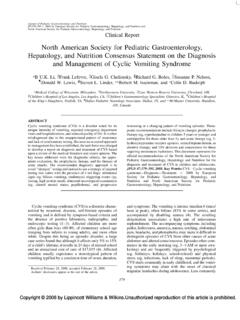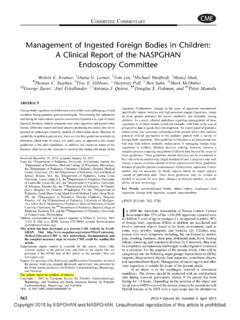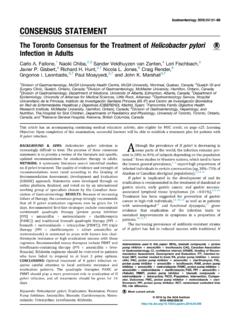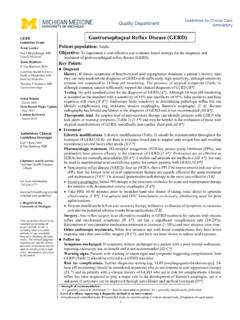Transcription of Joint ESPGHAN/NASPGHAN Guidelines for the …
1 Copyright ESPGHAL and naspghan . All rights ESPGHAN/NASPGHAN Guidelines for theManagement ofHelicobacter pyloriin Children andAdolescents (Update 2016) Nicola L. Jones,ySibylle Koletzko,zKaren Goodman, Patrick Bontems,jjSamy Cadranel, Thomas Casswall,#Steve Czinn, Benjamin D. Gold,yyJeannette Guarner,zzYoram Elitsur, Matjaz Homan,jjjjNicolas Kalach, Michal Kori,##Armando Madrazo, Francis Megraud,yyyAlexandra Papadopoulou, andzzzMarion Rowland, on behalf of espghan , NASPGHANABSTRACTB ackground:Because of the changing epidemiology ofHelicobacter pyloriinfection and low efficacy of currently recommended therapies, an update ofthe European Society for Paediatric Gastroenterology Hepatology andNutrition/North American Society for Pediatric Gastroenterology, Hepatol-ogy and Nutrition recommendations for the diagnosis and management ofHpyloriinfection in children and adolescents is :A systematic review of the literature (time period: 2009 2014) wasperformed.
2 Representatives of both societies evaluated the quality of evidenceusing GRADE (Grading of Recommendation Assessment, Development, andEvaluation) to formulate recommendations, which were voted upon andfinalized using a Delphi process and face-to-face :The consensus group recommended that invasive diagnostic testing forHpyloribe performed only when treatment willbe offered if tests are positive. Toreach the aim of a 90% eradication rate with initial therapy, antibiotics should betailored according to susceptibility testing.
3 Therapy should be administered for14 days, emphasizing strict regimensshouldberestrictedtochildreninfe cted with susceptible strains. Whenantibiotic susceptibility profiles are not known, high-dose triple therapy withproton pump inhibitor, amoxicillin, and metronidazole for 14 days or bismuth-based quadruple therapy is recommended. Success of therapy should bemonitored after 4 to 8 weeks by reliable noninvasive :The primary goal of clinical investigation is to identify thecause of upper gastrointestinal symptoms rather thanH , we recommend against a test and treat strategy.
4 Decreasingeradication rates with previously recommended treatments call for changesto first-line therapies and broader availability of culture or molecular-basedtesting to tailor treatment to the individual :adolescents, antibiotic susceptibility,13C-urea breath test,children, eradication,Helicobacter pylori , triple therapy(JPGN2017;64: 991 1003)Helicobacter pyloriinfection is acquired in childhood andremains an important cause of peptic ulcer disease (PUD)and gastric cancer (1). In comparison with adults, children andadolescents, however, infrequently develop these complications ofinfection.
5 FurthermoreH pyloriinfection in early childhood may beassociated with immunologic benefits later in life (2).The updated recommendations were extensively discussed inthe light of decreasing efficacy ofH pylorieradication therapy inchildren and the rising prevalence of antibiotic-resistant pyloriinfection is always associated with microscopicgastric inflammation, the overwhelming majority ofH pylori infected children are asymptomatic. Studies in children do notsupport a role forH pyloriinfection in functional disorders suchas recurrent abdominal pain (3).
6 Therefore in children the decisionto investigate and treat the infection should be supported by a clearbenefit for the individual is renewed hope in the potential for primary preventionof infection based on the results of a recent vaccine study in Chinesechildren (4). Optimization of the vaccine strategy is, however,required to ensure long-lasting protection. Furthermore, additionalstudies demonstrating efficacy in different geographic regions arealso needed before this vaccination strategy can be adopted inclinical recommended goal forH pyloritreatment is an eradica-tion rate of at least 90% to avoid further investigations andantibiotic use (5).
7 First-line therapies recommended in previousguidelines have unacceptable treatment failures rates (6). Thus,based on the declining prevalence of the infection in somecountries, and the ineffectiveness of previously recommendedfirst-line eradication therapies, European Society for PaediatricGastroenterology Hepatology and Nutrition ( espghan ) andNorth American Society for Pediatric Gastroenterology, Hepatol-ogy and Nutrition ( naspghan ) determined that updatedReceived July 4, 2016.
8 Accepted March 10, the Division of Gastroenterology, Hepatology and Nutrition, CellBiology Program, Sickkids Toronto, Departments of Paediatrics andPhysiology, University of Toronto, Toronto, Canada, theyDivision ofGastroenterology and Hepatology, Dr. von Hauner Children s Hospital,Ludwig Maximilians University, Munich, Germany, thezDepartment ofMedicine and School of Public Health, Centre of Excellence for Gastro-intestinal Inflammation and Immunity Research, University of Alberta,Edmonton, Alberta, Canada, the Paediatric Gastroenterology Depart-ment, Ho pital Universitaire des Enfants Reine Fabiola, thejjDepartmentof Paediatric Gastroenterology, Queen Fabiola University Children sHospital, Universite Libre de Bruxelles.
9 Brussels, Belgium, the Pediatric Gastroenterology, Hepatology, and Nutrition, CLINTEC,Karolinska Institutet and Karolinska University Hospital, Stockholm,Sweden, the#Department of Pediatrics, University of Maryland Schoolof Medicine, Baltimore, MD, the Children s Center for DigestiveHealthcare, LLC, Gi Care for Kids, LLC, Children s Healthcare ofAtlanta, theyyDepartment of Pathology and Laboratory Medicine, EmoryUniversity, Atlanta, GA, thezzDepartment of Pediatrics, Gastroenterol-ogy Division, Marshall University School of Medicine, Huntington, WV,the Faculty of Medicine, Department of Gastroenterology, Hepatologyand Nutrition, University Children s Hospital Ljubljana, Ljubljana, Slo-venia, thejjjjSaint Antoine Pediatric Clinic, Saint Vincent de PaulHospital, Groupement de l Institut Catholique de Lille (GH-ICL)
10 , Catho-lic University, Lille, France, the Kaplan Medical Center, HadassahMedical School, Hebrew University, Jerusalem, Israel, the##PediatricGastroenterology Division, Hospital de Pediatr a, Centro Medico Nacio-nal Siglo XXI, Mexico City, Mexico, the Laboratoire deBacte riologie, Universite de Bordeaux, Bordeaux, France, theyyyDivision of Gastroenterology, Hepatology and Nutrition, First Depart-ment of Pediatrics, University of Athens, Children s Hospital , Athens, Greece, and thezzzSchool of Medicine, UniversityCollege Dublin, Dublin, Volume 64, Number 6, June 2017991 Copyright ESPGHAL and naspghan .





